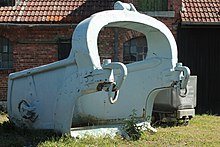Dragline excavators
A dragline excavator is a dragline crane and is mostly used as an open-pit mining device , e.g. B. to remove overburden .
Depending on the dimensions and the size of the open pit, it can also be used for transport and tipping in so-called direct collapse at the same time.
construction

A dragline excavator consists of a chassis and a rotating superstructure. A boom is attached to the superstructure, from which a scraper is suspended from ropes. The scraper with a volume of up to 120 m³ hangs freely on the vertical ropes. The scraper or, in the case of wet mining, the dragline shovel is pulled to the excavator with a horizontally attached rope . The bucket is opened and closed with another rope. Dragline excavators can move with crawler tracks or walking gear .
Dragline excavators are also used in open pit cultivation to design embankments.
Working method
The excavator is swiveled in the direction of the material to be excavated and the bucket is lowered. With the help of the horizontal rope, the bucket is pulled over the rock while scraping and filled. After the bucket has been filled, it is raised and the excavator rotates in the desired direction. When you arrive at the destination, the bucket is emptied. A means of transport is loaded much less frequently (e.g. heavy goods vehicles ).
Advantages and disadvantages
The use of dragline excavators has the following advantages:
- relatively low investment costs,
- low maintenance costs,
- high performance,
- With long outriggers, the overburden can be collapsed directly onto the dump without using any other means of transport (so-called direct collapse).
These points make it one of the open pit mining machines with the lowest specific operating costs .
This is offset by the following disadvantages:
- Can only be used in soft or blasted material due to the low pressure of the scraper,
- if means of transport are to be loaded (rather seldom), then it can only be tipped relatively imprecisely,
- the length of the boom limits the width of the working level of the pit (where the useful mineral is extracted), which can lead to space problems with large equipment.
literature
- Damiran, Purevsuren: Development of technical-technological concepts for the use of direct fall technology with dragline excavators in the brown coal opencast mines in Mongolia . Dissertation, TU Bergakademie Freiberg , 2007
- Б. В. Бокий: mining science . Technology, Berlin 1955, opencast mining excavator, p. 458–471 (Russian: Горное Дело . Translated by Dr. R. Staepken).
Individual evidence
- ↑ LMBV walking excavator goes on tour. In: lmbv.de. Retrieved July 4, 2015 .

